Зоологический журнал, 2019, T. 98, № 8, стр. 845-853
Two new Leptochitons (Mollusca, Polyplacophora, Leptochitonidae) from Madagascar and Mozambique
B. I. Sirenko *
Zoological Institute, Russian Academy of Sciences
199034 St. Petersburg, Russia
* E-mail: marine@zin.ru
Поступила в редакцию 31.10.2018
После доработки 28.01.2019
Принята к публикации 3.03.2019
Аннотация
Two new species of the genus Leptochiton are described: L. madagascaricus sp. n. from north Madagascar, depths 362 to 431 m, and L. blikshteini sp. n. from southern Mozambique Channel, depths 148 to 152 m. They are characterized by the relatively thick valves, the anteriorly located mucro and the longitudinal rows of granules in the central areas of the intermediate valves. Leptochiton madagascaricus sp. n. differs from similar species by having trapezoidal valves, closely set granules in the pleural areas of the intermediate valves, broad, dorsally bent scales with a wide bulbous base, and slender, numerous teeth of the radula. Leptochiton blikshteini sp. n. differs from other similar species from the southwestern Indian Ocean by having granules arranged staggered-order in the lateral and postmucronal areas and in elongate, flattened, sharply pointed dorsal spicules with 1–2 ribs.
Chitons studied here were collected during the two expeditions MIRIKY and MAINBAZA led by the Muséum national d’Histoire naturelle, Paris (MNHN), in 2009.
Specimens were prepared for scanning electron microscope (SEM) as usual (Sirenko, 2016).
Class Polyplacophora Gray 1821
Subclass Neoloricata Bergenhayn 1955
Order Lepidopleurida Thiele 1909
Family Leptochitonidae Dall 1889
Genus Leptochiton Gray 1847
Type species: Chiton cinereus of Montagu 1803 (non Linnaeus 1767) = Leptochiton asellus (Gmelin 1791) fide Lovén 1846, subsequent designation by Gray 1847.
Genus distribution: Worldwide, Carboniferous-Recent.
Leptochiton madagascaricus Sirenko sp. n. (Figs 1–3)
Fig. 1.
Leptochiton madagascaricus sp. n., Indian Ocean, Madagascar, holotype (MNHN IM-2009-16 616) BL – 8.5 mm: A – valve I, dorsal view; B – valve II, dorsal view; C – valve V, dorsal view; D – valve VIII, dorsal view; E – valve IV, ventral view; F – valve V, tegmentum sculpture in central area; G – valve V, rostral view; H – valve VIII, lateral view.
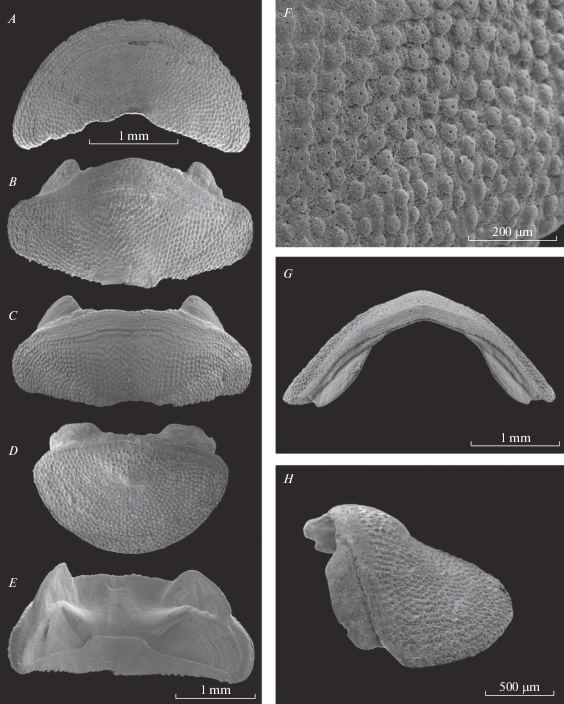
Fig. 2.
Leptochiton madagascaricus sp. n. Indian Ocean, Madagascar, holotype (MNHN IM-2009-16616) BL – 8.5 mm: A – dorsal and ventral scales; B, D – radula; C – dorsal scales.
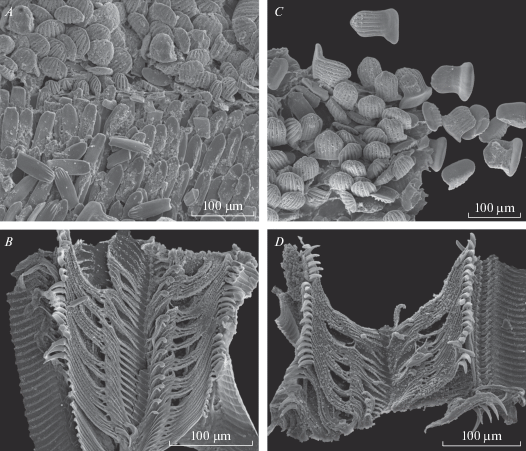
Fig. 3.
Leptochiton madagascaricus sp. n., Indian Ocean, Madagascar, holotype (MNHN IM-2009-16 616) BL – 8.5 mm: A – sutural needle; B – dorsal scale; C – marginal needle; D – ventral scale, ventral view; E – central and first lateral teeth of radula; F – major lateral tooth of radula; G – head of major lateral tooth of radula; H – aesthete group. Scale bar: A – G – 100 µm.
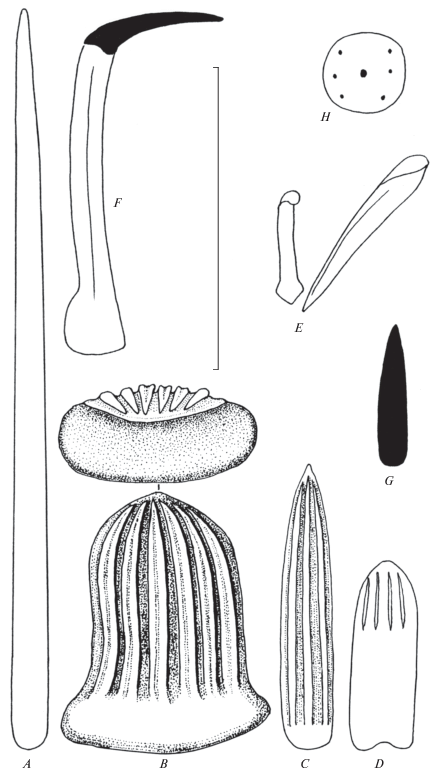
Type material. Holotype (MNHN IM-2009-16 616), now disarticulated consisting of SEM stub of valves I, II, IV, V, VIII, part of perinotum and radula, mount of part of perinotum and vial with other valves.
Type locality. Indian Ocean, North Madagascar, Ouest du Cap d’Ambre, 12°07′ S, 48°58′ E, 362–431 m (MIRIKY Stn DW3197, 28.06.2009, leg. P. Bouchet, N. Puillandre & B. Richer de Forges).
Description. Holotype (body length 8.5 mm) elongate oval in outline, valves thick, subcarinated, moderately elevated (dorsal elevation 0.42), posterior margin of intermediate valves damaged, side slopes convex, lateral areas raised; tegmentum white in color.
Head valve semicircular, almost as wide as the intermediate valves, posterior margin broadly V-shaped. Intermediate valves trapezoidal, anterior margin convex in jugal part and splayed laterally, side margins evenly rounded, hind margin damaged, lateral areas raised. Tail valve rather less than head valve anterior margin between apophyses protruding, with mucro anterior, posterior slope concave (Fig. 1D, 1H).
Tegmentum of head valve, lateral areas of intermediate valves and postmucronal area of tail valve sculptured with roundish, closely set granules arranged in a random manner . Central areas of intermediate valves and antemucronal area of tail valve sculptured with closely set longitudinal rows of small, roundish granules (about 60 rows in central areas and 32 rows in antemucronal area). Each granule with seven pores of aesthetes (Figs 1F; 3H).
Articulamentum well developed, white, apophyses narrow, triangular, with rounded top, wide apart in the intermediate valves, trapezoid in tail valve. There are excrescences between anterior margin of intermediate and tail valves and apophyses (Figs 1C, 1G).
Girdle very narrow, dorsally densely covered with broad, bent scales (55–85 × 60–70 µm) with wide bulbous base, each scale ornamented with six broad, sometimes double riblets, those near valves longer (up to 100 × 60 μm). Intersegmental areas with long smooth needles (up to 600 × 12 μm). Marginal needles (95 × 16 μm) flattened with ribs. Ventrally, the girdle is covered with obtuse pointed scales (52–65 × 20 μm) smooth in outer side and with 4–5 short riblets in inter side (Figs 2A, 2C; 3A–3D).
Enrico Schwabe (Zoologische Staatssamlung München, Germany, ZSM), who saw whole specimen of the holotype before disarticulation kindly informed me about length of radula and number of transverse rows of radula, and number of gills.
Radula of holotype 2.5 mm long with 160–180 transverse rows of mature teeth. Central tooth narrowing in front to a small blade, first lateral tooth narrow at the base, gradually slightly widening to a convex blade, slender major lateral teeth bearing sharply pointed unidentate cusp (Figs 2B, 2D; 3E–3G).
The holotype has nine gills.
Diagnosis. Animal small, moderately elevated, valves subcarinated, intermediate valves trapezoidal, splayed laterally, tail valve mucro anterior, postmucronal slope slightly concave, tegmentum of central and antemucronal areas sculptured with longitudinal rows of granules, tegmentum of head valve, lateral and postmucronal areas sculptured with granules arranged in a random manner; seven aesthete pores in each granule; girdle dorsally covered with broad, bent scales with bulbous base, each scale ornamented with six broad, sometimes double riblets; radula with many transverse rows of very small teeth, central and first lateral teeth elongate and narrow, long and slender major lateral teeth bearing sharply pointed unidentate cusp.
Distinctive diagnosis. This new species superficially resembles three species from southwestern and southern Indian Ocean: Leptochiton chariessa, L. meiringae and L. dispersus. L. madagascaricus sp. n. differs from L. chariessa in having granules in lateral and postmucronal areas arranged in a random manner (vs. in radial rows in L. chariessa), mucro anterior (vs. mucro slightly posterior in L. chariessa), 60 longitudinal rows on central areas (40–45 rows in L. chariessa).
The new species differs from L. meiringae by having trapezoidal intermediate valves (vs. broadly rectangular in L. meiringae), mucro anterior (vs. mucro posterior in L. meiringae), closely set granules on pleural areas (vs. wide interstices in L. meiringae), dorsal scales broad, bent with wide bulbous base (vs. elongate, bluntly pointed without bulbose base in L. meiringae).
L. madagascaricus sp. n. differs from L. dispersus by having regular longitudinal rows on central areas (vs. irregularly longitudinally displayed chains of small pustules in L. dispersus), mucro anterior (vs. mucro subcentral, but in fig. 5 (Kaas, Van Belle, 1987) mucro is posterior in L. dispersus), dorsal scales broad, bent with wide bulbous base (vs. elongated, bluntly pointed without bulbose base in L. dispersus).
Other leptochitons from southwestern Indian Ocean have granules in central area arranged quincuncially (vs. longitudinal rows in L. madagascaricus sp. n.). New species is superficially similar to Leptochiton gloriosus which type locality is very close to that of L. madagascaricus sp. n., but differs from it by having longitudinal rows of granules in central areas of intermediate valves (vs. quincuncially in L. gloriosus), seven, rare nine aesthete pores (vs. eleven pores in L. gloriosus, six wide, often double riblets in dorsal scales (vs. 6–8 narrow riblets in L. gloriosus), narrow and long central, first lateral and major lateral teeth of radula (short teeth in L. gloriosus).
Distribution. Only known from the type locality.
Etymology. Named after the island Madagascar.
Leptochiton blikshteyni Sirenko sp. n. Figs 4–7
Fig. 4.
Leptochiton blikshteini sp. n., Indian Ocean, Mozambique, holotype (MNHN IM-2009-16613) BL – 6.0 mm: A – valve I, dorsal view; B – valve II, dorsal view; C – valve V, dorsal view; D – valve VIII, dorsal view; E – valve IV, ventral view; F – valve V, tegmentum sculpture in central area; G – valve V, rostral view; H – valve VIII, lateral view.
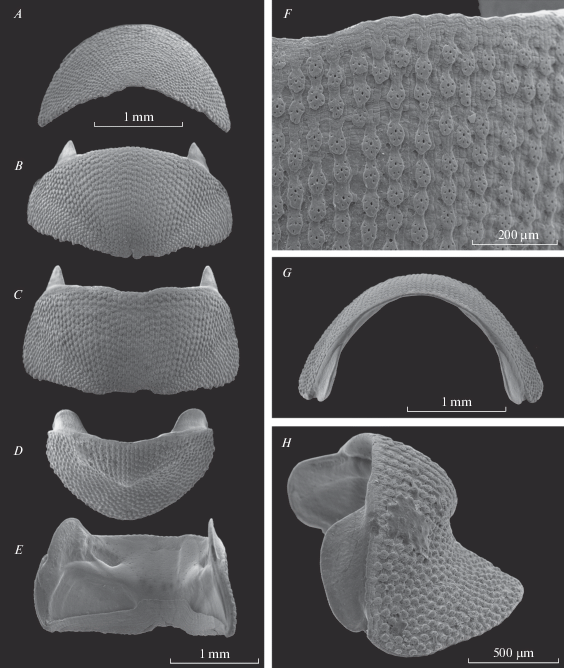
Fig. 5.
Leptochiton blikshteini sp. n., Indian Ocean, Mozambique, holotype (MNHN IM-2009-16613) BL – 6.0 mm: A, C – dorsal and ventral scales; B, D – radula.
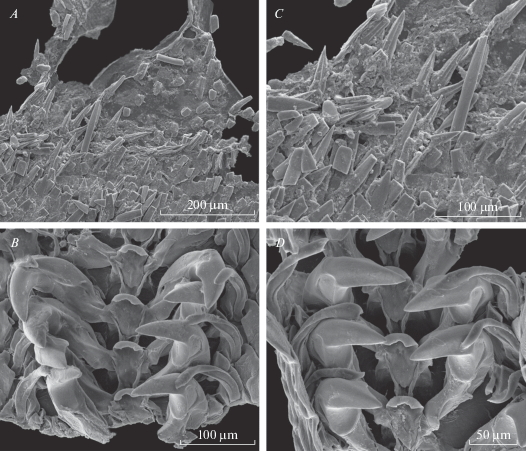
Fig. 6.
Leptochiton blikshteini sp. n., Indian Ocean, Mozambique, holotype (MNHN IM-2009-16613) BL – 6.0 mm: A – sutural needle; B – dorsal spicules; C – marginal needle; D – ventral spicules, near margin and in middle; E – ventral spicule near pallial groove; F – central and first lateral teeth of radula; G, H – heads of major lateral teeth of radula; I – aesthete group. Scale bar: A – I – 100 µm.
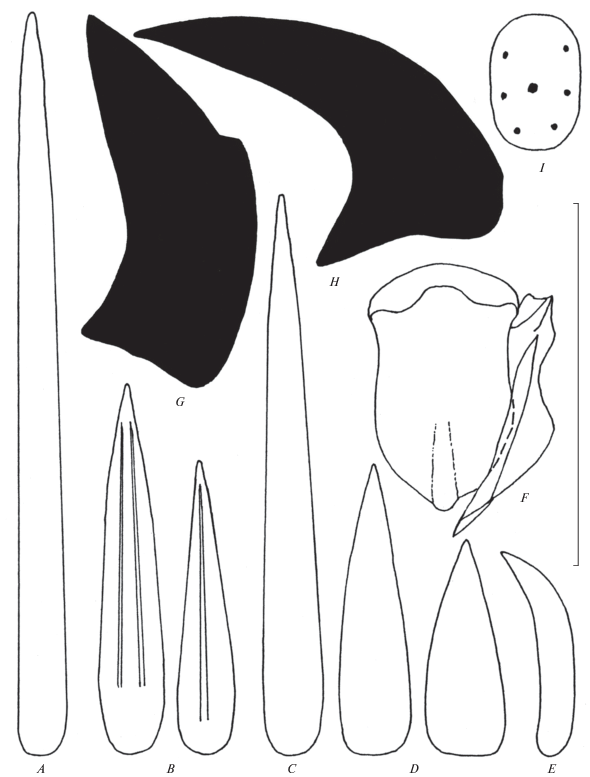
Fig. 7.
Leptochiton blikshteini sp. n., Indian Ocean, Mozambique, holotype (MNHN IM-2009-16613) BL – 6.0 mm: A – whole animal, dorsal view; B – whole animal, lateral view.
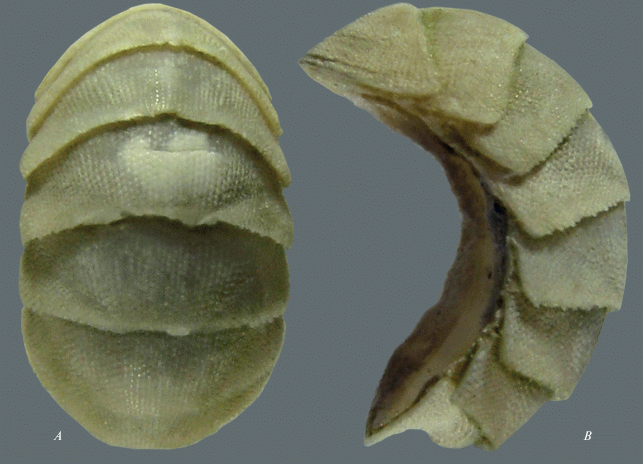
Type material. Holotype (MNHN IM-2009-16613) now disarticulated consisting of SEM stub of valves I, II, IV, V, VIII, part of perinotum and radula, mount of part of perinotum and vial with other valves.
Type locality. Indian Ocean, Mozambique Channel: 23°55′ S, 35°37′ E, 148–152 m (Inhambane transect, Campagne MAINBAZA, N.O. “Vizconde de Eza” Stn CC3159, 15.04.2009, leg. B. Bouchet, Rosado & H. Strong.
Description. Holotype 5.3 × 3.8 mm. Shell elongate-oval (Fig. 7), highly elevated (elevation ratio in valve V 0.50). Valves thick, rounded, not beaked, side slopes convex, lateral areas slightly raised color of tegmentum white.
Head valve semicircular. Intermediate valves almost rectangular, except valve II that trapezoidal, rather long and narrow, anterior and posterior margins in valves II–VII nearly straight, not beaked, lateral margins straight, valve II with convex anterior margin. Tail valve less than head valve, with slightly anterior mucro, antemucronal slope slightly convex, postmucronal slope decidedly concave near mucro (Figs 4D, 4H).
Tegmentum sculptured with flattened oval densely spaced granules, arranged in about 65 radial rows in head valve, in ca. 50 longitudinal rows in the central area of intermediate valves and antemucronal area of tail valve, and quincuncially in other areas. Each granule has one megalaesthete and six micraesthetes (Figs 4F; 6I).
Articulamentum moderatelly developed, apophyses short, narrow, width of apophyses more than 3 times less than width of jugal sinus.
Girdle very narrow, perinotum developed only from valve II to valve VII, and it is absent along head and tail valves, where hyponotum is present only, dorsally covered with elongate, flattened, sharply pointed spicules (85–103 × 19 μm) with 1–2 narrow ribs on the dorsal side. Intersegmental area with long smooth needles up to 200 × 14 μm. Marginal needles like intersegmental but shorter up to 160 × 15 μm. Ventrally girdle covered with elongate sharply pointed, smooth scales (64–83 × 20 μm) (Figs 5A, 5C; 6A–6E).
Radula of holotype 1.8 mm long with 21 transverse rows of mature teeth. Central tooth wide and with short projection on base. Major lateral teeth with unidentate cusps (Figs 5B, 5D; 6A–6E).
Nine gills per side arranged from valve VI to anus.
Diagnosis. Animal of a small size. Shell highly elevated, rounded. Intermediate valves almost rectangular except valve II that is trapezoidal. Tail valve narrower than the head valve, mucro slightly anterior, posterior slope decidedly concave. Tegmentum with flattened oval granules arranged in radial rows in the head valve, in longitudinal rows in the central area of intermediate valves and the antemucronal area of the tail valve and quincuncially in lateral and postmucronal areas. Each granule with seven pores of aesthetes. Girdle very narrow, perinotum developed only from valve II to valve VII. Dorsal spicules elongate, flattened, sharply pointed with 1–2 narrow ribs. Central teeth of radula wide, major lateral teeth with unidentate cusp. Nine gills per side extending from valve VI to anus.
Distinctive diagnosis. The new species is similar to Leptochiton madagascaricus sp. n., L. meiringae and L. chariessa. L. blikshteini sp. n. differs from L. madagascaricus sp. n. by having elongate, flattened, sharply pointed dorsal spicules with 1–2 ribs (vs. broad dorsal scales, bent with a wide bulbous base and 6 ribs in L. madagascaricus sp. n.), rounded valves (vs. subcarinated valves in L. madagascaricus sp. n), a radula with few transverse rows of teeth (vs. a radula with numerous transverse rows of small teeth in L. madagascaricus sp. n.).
The new species differs from L. meiringae by having slightly anterior mucro (vs. posterior mucro in L. meiringae), closely set granules in pleural areas (vs. wide interstices in L. meiringae), granules arranged quincuncially in lateral and postmucronal areas (vs. in radial rows in L. meiringae).
L. blikshteini sp. n. differs from L. chariessa by having rounded valves (vs. carinated valves in L. chariessa), granules arranged quincuncially in lateral and postmucronal areas (vs. in radial rows in L. chariessa), slightly anterior mucro (vs. slightly posterior mucro in L. chariessa).
Distribution. Only known from the type locality.
Etymology. Named after Mihael Blikshteyn (Portland, Oregon, U.S.A.) for his continuous and unselfish help preparing my manuscripts for publications.
ACKNOWLEDGEMENTS
I would like to thank Enrico Schwabe (ZSM) for his valuable comments, and additional informations on gills and radula of the holotype of L. madagascaricus, Philippe Bouchet (NMHN) for the loan material, Mihael Blikshteyn (Portland, Oregon, U.S.A.) for polishing English, Alexey Miroljubov (Zoological Institute of Russian Academy of Sciences, St. Petersburg ZISP) for his technical assistance with SEM procedures and Galina Kuznetsova (ZISP), who prepared the digital plates.
Scientific research was performed using equipment of the “Taxon” Research Resource Center (http://www.ckp-rf.ru/ckp/3038/?sphrase_id=8879024) of the Zoological Institute of the Russian Academy of Sciences (St. Petersburg). This work was supported by State scientific program “Fauna, ecology and biogeography of water invertebrates AAA-A17-1170303102 07-3”.
Список литературы
Barnard K.H., 1963. Contributions to the knowledge of South African marine Mollusca. IV. Gastropoda… Polyplacophora... // Annals of the South African Museum. V. 47. P. 201–360.
Kaas P., 1985. Notes on Loricata (Mollusca) 11–14 // Zoologische Mededelingen. Leiden. V. 59. № 25. P. 299–320.
Kaas P., 1985a. Chitons (Mollusca: Polyplacophora) procured by the French Benthédi Expédition, 1977, and the MD 32-Réunion Expédition, 1982, in the southwestern Indian Ocean. Zoologische Mededelingen. Leiden. V. 59. № 26. P. 321–340.
Kaas P., Van Belle R.A., 1985. Monograph of living chitons. 1, Order Neoloricata: Lepidopleurina. Leiden: E.J. Brill/W. Backhuys. 240 p.
Kaas P., Van Belle R.A., 1987. Monograph of living chitons. 3, Ischnochitonidae: Chaetopleurinae, Ischnochitoninae (pars). Leiden: E.J. Brill/ W. Backhuys. 302 p.
Leloup E., 1981. Chitons du Sud-Ouest de 1’Océan Indien // Bulletin de l’Institut Royal des Sciences Naturelles de Belgique. V 53. № 10. P. l–4.
Leloup E., 1981a. Chitons de Tuléar, Réunion, Maurice et Tahiti // Bulletin de l’Institut Royal des Sciences Naturelles de Belgique. V. 53. № 3. P. l–46.
Sirenko B.I., 2000. A new and unusual species of Parachiton (Mollusca: Polyplacophora) from South Africa // African Zoology. V. 35. № 1. P. 93–98.
Sirenko B.I., 2016. A new South African Leptochiton (Mollusca: Polyplacophora: Lepidopleurida // Ruthenica. V. 26. № 3–4. P. 145–151.
Дополнительные материалы отсутствуют.
Инструменты
Зоологический журнал


